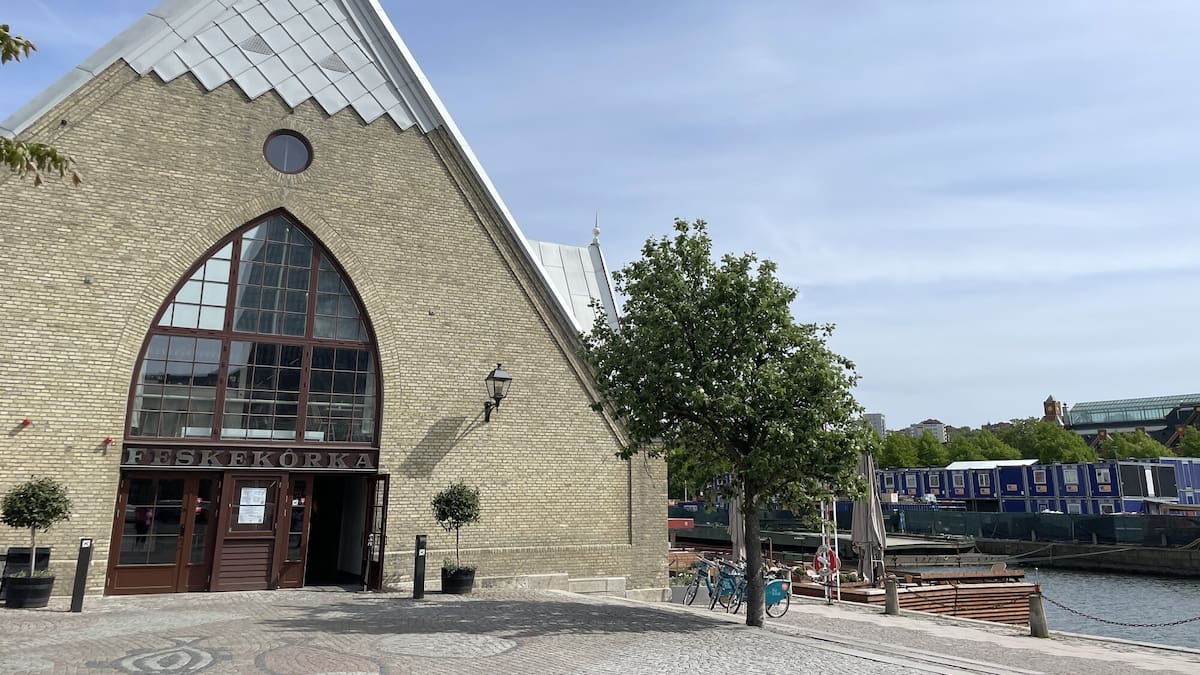This cobble-stoned quarter resembles a miniature Scandi Paris (but without the crowds), with fragrant wafts of freshly-baked bread filling the streets, and small cafes displaying their sweet treats in glass-fronted displays. Impressed – and only slightly frightened – by cinnamon rolls as large as my head, I ventured inside Cafe Husaren. This corner cafe is well-known in the city for making its signature giant cinnamon rolls, called “Hagabullen”. Don’t be scared by the size – you can order them in quarters, so you don’t spoil your appetite for other culinary delights.
Cinnamon rolls are a big thing in Sweden. They get their own day in the calendar (October 4), but in reality, every day is cinnamon roll day in this corner of the country. The typical pastry is one of many that Swedes enjoy during “fika” – a moment to enjoy a coffee and a sweet bite while chatting with a friend, colleague or family.
“Fika is a very democratic thing here in Sweden – everyone enjoys it, from your next-door neighbour to the Swedish royals,” explains fika tour guide Kersti Wenstin. She leads a whole tour dedicated to the practice in the neighbouring town of Alingsas, the birthplace of fika. Only 30 minutes from Gothenburg, Alingsas makes a great half-day trip for those curious to experience smaller town vibes.
But you don’t have to leave the city to enjoy outstanding bites. In and around Haga, you will find plenty of places to fika, such as an open-air cafe like da Matteo, where you’re also in the heart of the action for some amazing vintage shopping. Vallgatan is the street to follow if you’re looking for any boutique selling first-edition books, records, 80s clothing, trinkets and everything in between.
The best way to explore Gothenburg is by following the course of the canal, as it snakes its way through the city centre and culminates in the mouth of the river Gota. And what better way to learn more about the city than asking the father himself?
Keeping an eye on its brethren, the bronze statue of Gothenburg’s founder, Gustav Adolf, overlooks the main square – not just of historical interest, but also one of the liveliest spots in the city. It’s tempting to spend hours in this urban pantheon and observe people biking by the glistening river, the bells sounding in the background, and the city’s bright blue trams whizzing by.
But my favourite part of the city is the bohemian, dreamy quarter located just a few steps from the cathedral. If you have a few Scandi trips under your belt, you may spot a familiar sight as you enter the gardens of Gothenburg Cathedral. Encrusted in starfish, shell, and various marine shapes is “the Oracle” of the city, a bronze mermaid-like creature sitting and keeping guard of the urban realm. Unlike its cousin mermaid in Copenhagen, the Oracle’s mission is not to look far at sea, but to look at the heart of the city, and answer one question from anyone who sits next to her.
You’re not supposed to share your question, but I’m not ashamed to say mine ran along the lines of: where should I go for lunch?
The south bank of the canal is where the best of Gothenburg’s food scene is gathered. Half religious experience, half fresh seafood market, the Feskekorka is, without putting too many frills on it, a “fish church”. Yes, that’s right: it’s a fish market … and people get married here. If it’s not your big day, you can still walk down the aisle and say “I do” when the friendly stall vendors ask you if you’d like to try the smoked herring with fresh dill, served on a rye crispbread. The Feskekorka’s neo-Gothic structure is meant to look like a medieval church, but despite appearances, the building is not consecrated in any way, apart from the “goddess of the sea”, as local fish vendor Hakan likes to describe it.
From the fish church, you have lots of other quirky spots within walking distance. If you want to taste Swedish meatballs, stop at casual KottbulleKallaren. Or if you’re feeling international, South American Tranquilo is popular for its cheap but filling bites. And for being right next to a charming speakeasy, hidden behind an unassuming brown door (you didn’t hear it from me).
You can enjoy Scandi fare with a modern Mediterranean twist at Barabicu, a great lunch spot if you want to take a seat overlooking the peaceful canal, or book a special dinner at VRA. One of the trailblazers of revitalising the traditional seafood scene in South-western Sweden, this Japanese-style restaurant is credited with turning the invasive Pacific oyster into a local delicacy that also helps the environment. The cooking style may be overtly Japanese, but ingredients are strictly local, from the salmon used for the sashimi to the crispy seaweed. My favourite course at VRA is the mouth-watering cloudberry dessert with caramelised seaweed harvested in the archipelago, mere kilometres away.
Nested between the river and the sea, it’s no surprise so much of Gothenburg’s identity revolves around water. The part of town facing the sea is the most modernised, where you can spot some of the tallest buildings, including the Hotel Draken, an ideal spot to spend the night if you want to enjoy the sunrise over the mouth of the Gota river. On the opposite side of town, the jagged and spiky Göteborgsoperan is a perfect example of new, bold designs. But they certainly don’t take away the spotlight from the 17th-century-built Skansen Lejonet fortress with its rough stone, or even the New Alvsborg Fortress, an architectural marvel of a strategic castle built at sea.
Looking over the stunning archipelago, the fortress is where I reluctantly say goodbye to Gothenburg, thank her for nourishing me with splendid food and unforgettable sights, and vow to return again.
The writer travelled at their own expense.
